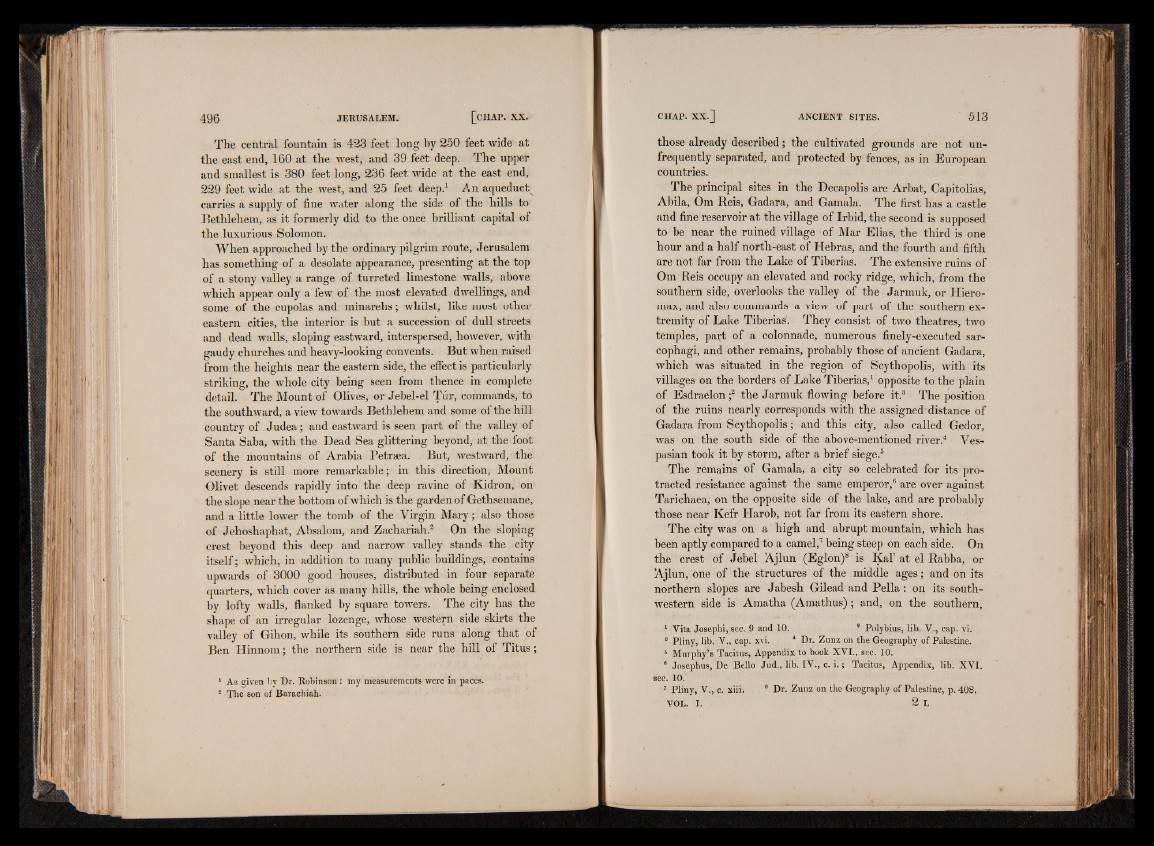
The central fountain is 423 feet long by 250 feet wide at
the east end, 160 at the west, and 39 feet deep. The upper
and smallest is 380 feet long, 236 feet wide at the east end,
229 feet wide at the west, and 25 feet deep.1 An aqueduct^
carries a supply of fine water along the side of the hills to
Bethlehem, as it formerly did to the once brilliant capital of
the luxurious Solomon.
When approached by the ordinary pilgrim route, Jerusalem
has something of a desolate appearance, presenting at the top
of a stony valley a range of turreted limestone walls, above
which appear only a few of the most elevated dwellings, and
some of the cupolas and minarehs; whilst, like most other
eastern cities, the interior is but a succession of dull streets
and dead walls, sloping eastward, interspersed, however, with
gaudy churches and heavy-looking convents. But when raised
from the heights near the eastern side, the effect is particularly
striking, the whole city being seen from thence in complete
detail. The Mount of Olives, or Jebel-el Tur, commands, to
the southward, a view towards Bethlehem and some of the hill
country of Judea; and eastward is seen part of the valley of
Santa Saha, with the Dead Sea glittering beyond, at the foot
of the mountains of Arabia Petrsea. But, westward, the
scenery is still more remarkable; in this direction, Mount
Olivet descends rapidly into the deep ravine of Kidron, on
the slope near the bottom of which is the garden of Gethsemane,
and a little lower the tomb of the Virgin Mary; also those
of Jehoshaphat, Absalom, and Zachariah.2 On the sloping
crest beyond this deep and narrow valley stands the city
itself; which, in addition to many public buildings, contains
upwards of 3000 good houses, distributed in four separate
quarters, which cover as many hills, the whole being enclosed
by lofty walls, flanked by square towers. The city has the
shape of an irregular lozenge, whose western side skirts the
valley of Gihon, while its southern side runs along that of
Ben Hinnom; the northern side is near the hill of Titus;
1 As given by Dr. Robinson : my measurements were in paces.
2 The son of Barachiah.
those already described; the cultivated grounds are not un-
frequently separated, and protected by fences, as in European
countries.
The principal sites in the Decapolis are Arbat, Capitolias,
Abila, Om Reis, Gadara, and Gamala. The first has a castle
and fine reservoir at the village of Irbid, the second is supposed
to be near the ruined village of Mar Elias, the third is one
hour and a half north-east of Hebras, and the fourth and fifth
are not far from the Lake of Tiberias. The extensive ruins of
Om Reis occupy an elevated and rocky ridge, which, from the
southern side, overlooks the valley of the Jarmuk, or Hiero-
max, and also commands a view of part of the southern extremity
of Lake Tiberias. They consist of two theatres, two
temples, part of a colonnade, numerous finely-executed sarcophagi,
and other remains, probably those of ancient Gadara,
which was situated in the region of Scythopolis, with its
villages on the borders of Lake Tiberias,1 opposite to the plain
of Esdraelon;2 the Jarmuk flowing before it.3 The position
of the ruins nearly corresponds with the assigned distance of
Gadara from Scythopolis; and this city, also called Gedor,
was on the south side of the above-mentioned river.4 Vespasian
took it by storm, after a brief siege.5
The remains of Gamala, a city so celebrated for its protracted
resistance against the same emperor,6 are over against
Tarichaea, on the opposite side of the lake, and are probably
those near Kefr Harob, not far from its eastern shore.
The city was on a high and abrupt mountain, which has
been aptly compared to a camel,7 being steep on each side. On
the crest of Jebel Ajlun (Eglon)8 is Kal’ at el Rabba, or
Ajlun, one of the structures of the middle ages ; and on its
northern slopes are Jabesh Gilead and Pella: on its southwestern
side is Amatha (Amathus); and, on the southern,
1 Vita Josephi, sec. 9 and 10. 2 Polybius, lib. V., cap. vi.
8 Pliny, lib. V., cap. xvi. 4 Dr. Zunz on the Geography of Palestine.
5 Murphy’s Tacitus, Appendix to book XVI., sec. 10.
* Josephus, De Bello Jud., lib. IV., c. i . ; Tacitus, Appendix, lib. XVI.
sec. 10.
7 Pliny, V., c. xiii; 8 Dr. Zunz on the Geography of Palestine, p. 408.
YOL. I. 2 L